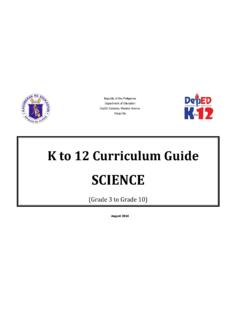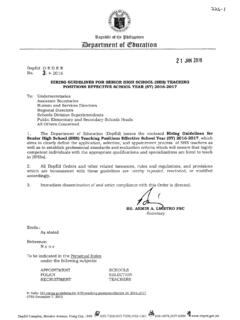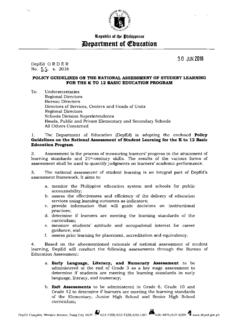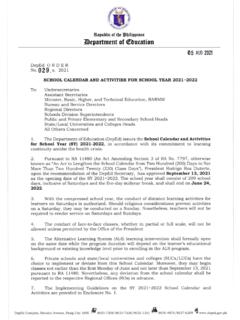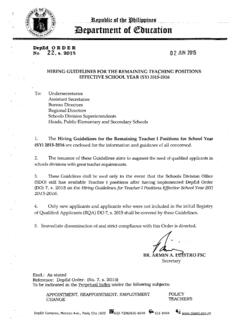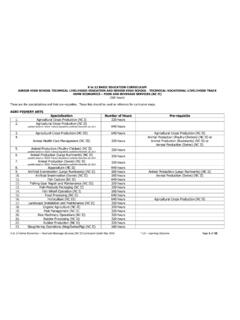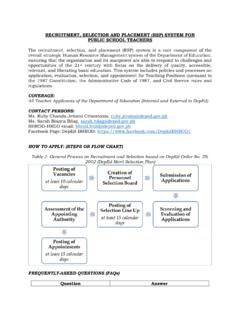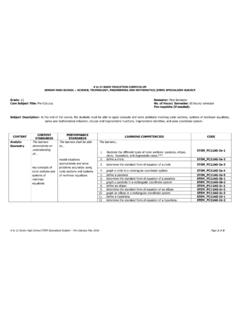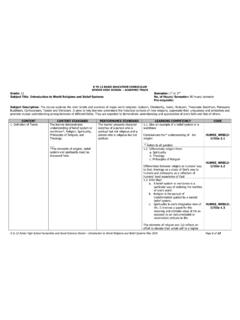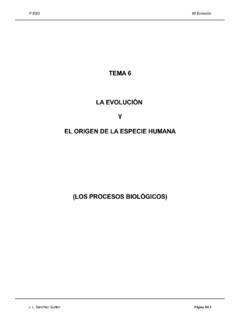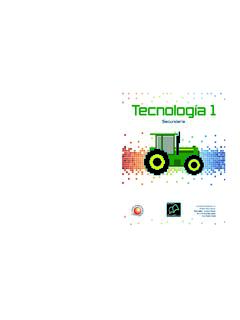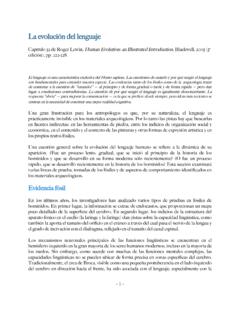Transcription of K to 12 BASIC EDUCATION CURRICULUM SENIOR HIGH …
1 K to 12 BASIC EDUCATION CURRICULUM SENIOR high SCHOOL CORE SUBJECT K to 12 SENIOR high School Core CURRICULUM Understanding Culture, Society and Politics December 2013 Page 1 of 8 Grade: 11 or 12 Core Subject Title: Understanding Culture, Society and Politics No. of hours/semester: 80 hours Course Description: This course uses insights from Anthropology, Political Science, and Sociology to develop students awareness of cultural, social and political dynamics, and sensitivity to cultural diversity; provide them with an understanding of how culture, human agency, society and politics work; and engage them in the examination of the country s current human development goals. At the end of the course, students should acquire ideas about human cultures, human agency, society and politics; recognize cultural relativism and social inclusiveness to overcome prejudices; and develop social and cultural competence to guide their interactions with groups, communities, networks, and institutions.
2 CONTENT CONTENT STANDARD PERFORMANCE STANDARD LEARNING COMPETENCY CODE A. Starting points for the understanding of culture, society, and politics 1. Sharing of social and cultural backgrounds of students as acting subjects or social actors, agents, persons; (examples: gender, socioeconomic class, ethnicity, religion, exceptionality/non-exceptionality, nationality) 2. Observations about social, political, and cultural behavior and phenomena (examples: food taboos, istambay, political dynasties, elections) 3. Observations on social, political,and cultural change (examples: txting, transnational families, local public services, youth volunteerism) 4. Definition of anthropology, political science, and sociology The learners demonstrate an understanding of: 1. human cultural variation, social differences, social change, and political identities 2. the significance of studying culture, society, and politics 3.
3 The rationale for studying anthropology, political science, and sociology The learners: 1. acknowledge human cultural variation, social differences, social change, and political identities 2. adopt an open and critical attitude toward different social, political, and cultural phenomena through observation and reflection 3. appreciates the value of disciplines of Anthropology, Sociology, and Political Science as social sciences The learners: 1. articulate observations on human cultural variation, social differences, social change, and political identities UCSP11/12 SPU-Ia-1 2. demonstrate curiosity and an openness to explore the origins and dynamics of culture and society, and political identities UCSP11/12 SPU-Ia-2 3. analyze social, political, and cultural change UCSP11/12 SPU-Ib-3 K to 12 BASIC EDUCATION CURRICULUM SENIOR high SCHOOL CORE SUBJECT K to 12 SENIOR high School Core CURRICULUM Understanding Culture, Society and Politics December 2013 Page 2 of 8 CONTENT CONTENT STANDARD PERFORMANCE STANDARD LEARNING COMPETENCY CODE 4.
4 Recognize the common concerns or intersections of anthropology, sociology, and political science with respect to the phenomenon of change UCSP11/12 SPU-Ib-4 5. identify the subjects of inquiry and goals of Anthropology, Political Science, and Sociology UCSP11/12 SPU-Ib-5 B. Defining Culture and Society from the perspectives of anthropology and sociology 1. Society as a group of people sharing a common culture 2. Culture as a that complex whole which encompasses beliefs, practices, values, attitudes, laws, norms, artifacts, symbols, knowledge, and everything that a person learns and shares as a member of society. ( Tylor 1920 [1871]). 3. Aspects of Culture a. Dynamic, Flexible, & Adaptive b. Shared & Contested (given the reality of social differentiation) c. Learned through socialization or enculturation d. Patterned social interactions e. Integrated and at times unstable f. Transmitted through socialization/enculturation g.
5 Requires language and other forms of communication 4. Ethnocentrism and Cultural Relativism as orientations in viewing other cultures 1. culture and society as anthropological and sociological concepts 2. perspectives in/approaches to the study of culture and society ( , comparative, historical, structural-functional, interpretive, critical) 1. appreciate the nature of culture and society from the perspectives of anthropology and sociology 2. demonstrate a holistic understanding of culture and society 3. values cultural heritage and express pride of place without being ethnocentric 1. explain anthropological and sociological perspectives on culture and society UCSPC11 DCS-Ic-6 2. describe society and culture as a complex whole UCSPC11/12 DCS-Ic-7 3. identify aspects of culture and society UCSP11/12 DCS-Ic-8 4. raise questions toward a holistic appreciation of cultures and societies UCSP11/12 DCS-Id-9 5.
6 Become aware of why and how cultural relativism mitigates ethnocentrism UCSP11/12 DCS-Id-10 6. identify forms of tangible and intangible heritage and the threats to these UCSP11/12 DCS-Ie-11 K to 12 BASIC EDUCATION CURRICULUM SENIOR high SCHOOL CORE SUBJECT K to 12 SENIOR high School Core CURRICULUM Understanding Culture, Society and Politics December 2013 Page 3 of 8 CONTENT CONTENT STANDARD PERFORMANCE STANDARD LEARNING COMPETENCY CODE C. Looking back at Human Biocultural and Social Evolution 1. Biological and cultural evolution: from homo habilis (or earlier) to homo sapiens sapiens in the fossil record 2. Cultural and sociopolitical evolution: from hunting and gathering to the agricultural, industrial , and post-industrial revolutions a. The Neolithic Revolution b. Early civilization and the rise of the state c. Democratization 1. the human origins and the capacity for culture 2.
7 The role of culture in human adaptation 3. processes of cultural and sociopolitical evolution Analyze key features of interrelationships of biological, cultural and sociopolitical processes in human evolution that can still be used and developed 1. trace the biological and cultural evolution of early to modern humans UCSP11/12 HBS-Ie-12 2. explore the significance of human material remains and artefactual evidence in interpreting cultural and social, including political and economic, processes UCSP11/12 HBS- If-13 3. recognize national, local, and specialized museums, and archaeological and historical sites as venues to appreciate and reflect on the complexities of biocultural and social evolution as part of being and becoming human UCSP11/12 HBS- If-14 D. Becoming a member of society 1. Enculturation/Socialization a. Identity formation (identities, disciplines, and aspirations) b.
8 Norms and values c. Statuses and roles ( age, gender) 2. Conformity and deviance a. Social control (gossip, social ostracism, laws and punishments) b. Forms of deviance (ritualism, retreatism, rebellion, and innovation) 3. Human dignity, rights, and the common good 1. how individuals learn culture and become competent members of society 1. identify norms and values to be observed in interacting with others in society, and the consequences of ignoring these rules 1. explain the development of one s self and others as a product of socialization and enculturation UCSP11/12 BMS-Ig-15 2. assess the rules of social interaction to maintain stability of everyday life and the role of innovation in response to problems and challenges 2. identify the context, content, processes, and consequences of enculturation and socialization UCSP11/12 BMS-Ig-16 K to 12 BASIC EDUCATION CURRICULUM SENIOR high SCHOOL CORE SUBJECT K to 12 SENIOR high School Core CURRICULUM Understanding Culture, Society and Politics December 2013 Page 4 of 8 CONTENT CONTENT STANDARD PERFORMANCE STANDARD LEARNING COMPETENCY CODE 2.
9 How individuals should behave as part of a political community 3. recognize the value of human rights and promote the common good 3. Identifies the social goals and the socially acceptable means of achieving these goals UCSP11/12 BMS-Ih-17 4. advocate inclusive citizenship UCSP11/12 BMS-Ih-18 5. promote protection of human dignity, rights, and the common good UCSP11/12 BMS- Ih-19 E. How society is organized 1. Groups within society: Primary and Secondary 2. In-groups and out-groups 3. Reference groups 4. Networks F. Cultural, social and political institutions 1. Kinship, marriage, and the household a. Kinship by blood Descent and marriage (unilineal, matrilineal, patrilineal, bilateral) b. Kinship by marriage Marriage rules cross-culturally (monogamy vs. polygamy, post-marital residency rules, referred marriage 1. cultural, social, and political institutions as sets of norms and patterns of behavior that relate to major social interests 2.)
10 Social stratification as the ranking of individuals according to wealth, power, and prestige 1. analyze aspects of social organization 2. identify one s role in social groups and institutions 3. recognize other forms of economic transaction such as sharing, gift exchange, and redistribution in his/her own society 1. traces kinship ties and social networks UCSP11/12 HSO-IIi-20 2. describe the organized nature of social life and rules governing behavior UCSP11/12 HSO-IIi-21 K to 12 BASIC EDUCATION CURRICULUM SENIOR high SCHOOL CORE SUBJECT K to 12 SENIOR high School Core CURRICULUM Understanding Culture, Society and Politics December 2013 Page 5 of 8 CONTENT CONTENT STANDARD PERFORMANCE STANDARD LEARNING COMPETENCY CODE partners) c. Kinship by ritual (Compadrazgo) d. Family and the household Nuclear, extended, and reconstituted families (separated, transnational) e.

